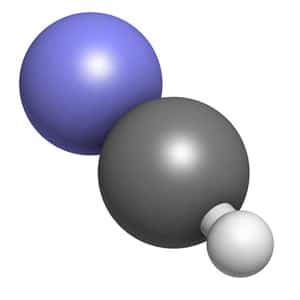
How It’s Used
Hydrogen cyanide (aka prussic acid, if in aqueous solution; and formonitrile) is a highly volatile, colorless, and extremely poisonous liquid (boiling point at just above room temperature). Its application as a poison is well known, represented in gas chambers and infamously in Zyklon B, used by the Nazis. While these methods of delivery involve the gas phase, the pits of many fruits contain cyanogenic compounds—that release hydrogen cyanide when chewed or digested. Indeed, this was known to the ancient Egyptians and Romans, who ground up peach pits to create poisons.
Hydrocyanic acid (aqueous solution) is utilized in the manufacture of products such as acrylonitrile, adiponitrile, cyanogen chloride, cyanuric chloride, acrylates and methacrylates, ferrocyanide, and chelating agents. It is also used as an insecticide and rodenticide, usually applied by fumigation. Additional applications are in paper, textiles, synthetic rubber,and plastics manufacturing. Cyanide salts are used in metallurgy for electroplating, metal cleaning, and removing gold from its ore.
Occupational Health/Toxicology
Hydrogen cyanide is highly toxic because it inhibits cellular oxidative processes. The substance can be absorbed into the body by inhalation, through the skin, and by ingestion. Acute exposure to lower concentrations of HCN will cause a variety of effects, such as weakness, headache, nausea, increased rate of respiration, and eye and skin irritation.
Chronic exposure to cyanide via inhalation results in effects on the central nervous system, such as headaches, dizziness, numbness, tremor, and loss of visual acuity. Other effects include cardiovascular issues and an enlarged thyroid gland.
Full record on hydrogen cyanide from Hazardous Substances Data Bank (HSDB), a database provided by the US National Library of Medicine.
The hydrogen cyanide entry from NIOSH’s Pocket Guide to Chemical Hazards.
Monitoring Instrumentation
Check out Interscan’s full line of hydrogen cyanide gas detection/gas monitoring instrumentation.
